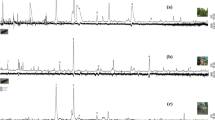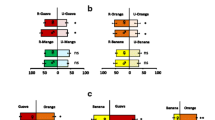Abstract
Solid-phase microextraction (SPME) and gas chromatography coupled with electroantennographic detection (GC-EAD) were used to identify volatile compounds from hawthorn fruit (Crataegus spp.) acting as behavioral attractants for hawthorn-infesting Rhagoletis pomonella flies. Consistent EAD activity was obtained for six chemicals: ethyl acetate (94.3%), 3-methylbutan- 1-ol (4.0%), isoamyl acetate (1.5%), 4,8-dimethyl-1,3(E),7-nonatriene (0.07%), butyl hexanoate (0.01%), and dihydro-β-ionone (0.10%). In a flight-tunnel bioassay, there was a dose-related increase in the percentage of flies flying upwind to the six-component mixture. Hawthorn-origin flies also made equivalent levels of upwind flight with the synthetic blend and an adsorbent extract of volatiles collected from whole fruit, each containing the same amount of the 3-methylbutan-1-ol compound. Significantly lower levels of upwind flight occurred to a previously identified volatile blend of ester compounds that attracts R. pomonella flies infesting domestic apples, compared with the hawthorn volatile mix. Selected subtraction assays showed further that the four-component mixture of 3-methylbutan-1-ol, 4,8-dimethyl-1,3(E),7-nonatriene, butyl hexanoate, and dihydro-β-ionone also elicited levels of upwind flight equivalent to the six-component mix. Removal of 3-methylbutan-1-ol from the four-component blend resulted in complete loss of upwind flight behavior. Removal of dihydro- β-ionone, 4,8-dimethyl-1,3(E),7-nonatriene, or butyl hexanoate from the four-component mixture resulted in significant decreases in the mean number of upwind flights compared to the four- or six-component mixtures.
Similar content being viewed by others
References
Agelopoulos, N. G. and Pickett, J. A. 1998. Headspace analysis in chemical ecology: Effects of different sampling methods on ratios of volatile compounds present in headspace samples. J. Chem. Ecol. 24:1161–1172.
Bartelt, R. J. 1997. Calibration of a commercial solid-phase microextraction device for measuring headspace concentrations of organic volatile. Anal. Chem. 69:364–372.
Berlocher, S. H. and Feder, J. L. 2002. Sympatric speciation in phytophagous insects: moving beyond controversy? Annu. Rev. Entomol. 47:773–815.
Bhasin, A., Mordue (LUNTZ), A. J., and Mordue, W. 2000. Responses of the biting midge Culicoides impunctatus to acetone, CO2 and 1–octen-3–ol in a wind tunnel. Med. Vet. Entomol. 14:300–307.
Bjostad, L. B. 1998. Electrophysiological Methods, pp. 339–375, in J. G. Millar and K. F. Haynes (Eds.). Methods in Chemical Ecology: Chemical Methods. Vol 1. Kluwer Academic, Norwell, Massachusetts.
Brady, J., Gibson, G., and Packer, M. J. 1989. Odour movement, wind direction, and the problem of host-finding by tsetse flies. Physiol. Entomol. 14:369–380.
Bush, G. L. 1966. The Taxonomy, Cytology, and Evolution of the Genus Rhagoletis in North America (Diptera: Tephritidae). Museum of Comparative Zoology, Cambridge, Massachusetts.
Colvin, J., Brady, J. and Gibson, G. 1989. Visually-guided turning behaviour of free-flying tsetse flies in odour-laden wind: a wind-tunnel study. Physiol. Entomol. 14:31–39.
Cossé, A. A. and BakerT. C. 1996. House flies and pig manure volatiles: wind tunnel behavioral studies and electrophysiological evaluations. J. Agric. Entomol. 13:301–317.
Feder, J. L. 1998. The apple maggot fly, Rhagoletis pomonella: Flies in the face of conventional wisdom?, pp. 130–144, in D. J. Howard, and S. H. Berlocher, (Eds.). Endless Forms: Species and Speciation. Oxford University Press, Oxford.
Feder, J. L. and Bush, G. L. 1989. A field test of differential host-plant usage between two sibling species of Rhagoletis pomonella fruit flies and its consequences for sympatric models of speciation. Evolution 43:1813–1819.
Feder, J. L., Chilcote, C. A. and Bush, G. L. 1988. Genetic differentiation between sympatric host races of Rhagoletis pomonella. Nature 336:61–64.
Feder, J. L., Chilcote, C. A. and Bush, G. L. 1990. The geographic pattern of genetic differentiation between host associated populations of Rhagoletis pomonella in the eastern United States and Canada. Evolution 44:570–594.
Feder, J. L., Hunt, T. A. and Bush, G. L. 1993. The effects of climate, host plant phenology and host fidelity on the genetics of apple and hawthorn infesting races of Rhagoletis pomonella. Entomol. Exp. Appl. 69:117–135.
Feder, J. L., Opp, S. B., Wlazlo, B., Reynolds, K., Go, W. and Spisak, S. 1994. Host fidelity is an effective pre-mating barrier between sympatric races of the apple maggot fly. Proc. Natl. Acad. Sci. USA 91:7990–7994.
Feder, J. L., Berlocher, S. H. and Opp, S. B. 1998. Sympatric host race formation and speciation in Rhagoletis (Diptera: Tephritidae): a tale of two species for Charles D., pp. 408–411, in S. Mopper and S. Strauss (Eds.). Genetic Structure and Local Adaptation in Natural Insect Populations: Effects of Ecology, Life History, and Behavior. Chapman and Hall, London.
Fein, B. L., Reissig, W. H. and Roelofs, W. L. 1982. Identification of apple volatiles attractive to the apple maggot, Rhagoletis pomonella. J. Chem. Ecol. 8:1473–1487.
Gibson, G. and Brady, J. 1985. “Anemotactic” flight paths of tsetse flies in relation to host odour: a preliminary video study in nature of the response to loss of odour. Physiol. Entomol. 10:395–406.
Greenwald, R., Chaykovsky, M., and Corey, E. J. 1963. The Wittig reaction using methylsulfinyl carbanion-dimethyl sulfoxide. J. Org. Chem. 28:1128–1129.
Horowitz, P. and Hill, W. 1989. RC filters pp. 35–39, in P. Horowitz and W. Hill (Eds.). The Art of Electronics. Cambridge University Press, New York.
Meats, A. and Hartland, C. L. 1999. Upwind anemotaxis in response to the cue-lure by the Queensland fruit fly, Bactrocera tryoni. Physiol. Entomol. 24:90–97.
Neilson, W. T. A. and McAllen, J. W. 1965. Artificial diets for the apple maggot. III. Improved, defined diets. J. Econ. Entomol. 58:542–543.
Prokopy, R. J., Bennett, E. W. and Bush, G. L. 1971. Mating behavior in Rhagoletis pomonella (Diptera: Tephritidae). I. Site of assembly. Can. Entomol. 103:1405–1409.
Prokopy, R. J., Bennett, E. W. and Bush, G. L. 1972. Mating behavior in Rhagoletis pomonella (Diptera: Tephritidae). II. Temporal organization. Can. Entomol. 104:97–104.
Prokopy, R. J., Moericke, V. and Bush, G. L. 1973. Attraction of apple maggot flies to odor of apples. Environ. Entomol. 2:743–749.
Prokopy, R. J., Diehl, S. R. and CooleyS. S. 1988. Behavioral evidence for host races in Rhagoletis pomonella flies. Oecologia 76:138–147.
Reissig, W. H., Fein, B. L. and Roelofs, W. L. 1982. Field tests of synthetic apple volatiles as apple maggot (Diptera: Tephritidae) attractants. Environ. Entomol. 11:1294–1298.
Zhang, A., Linn, Jr. C., Wright, S., Prokopy, R., Reissig, W. and Roelofs, W. 1999. Identification of a new blend of apple volatiles attractive to the apple maggot, Rhagoletis pomonella. J. Chem. Ecol. 25:1221–1232.
Author information
Authors and Affiliations
Corresponding author
Rights and permissions
About this article
Cite this article
Nojima, S., Linn, C., Morris, B. et al. Identification of Host Fruit Volatiles from Hawthorn (Crataegus spp.) Attractive to Hawthorn-Origin Rhagoletis pomonella Flies. J Chem Ecol 29, 321–336 (2003). https://doi.org/10.1023/A:1022677827233
Issue Date:
DOI: https://doi.org/10.1023/A:1022677827233




